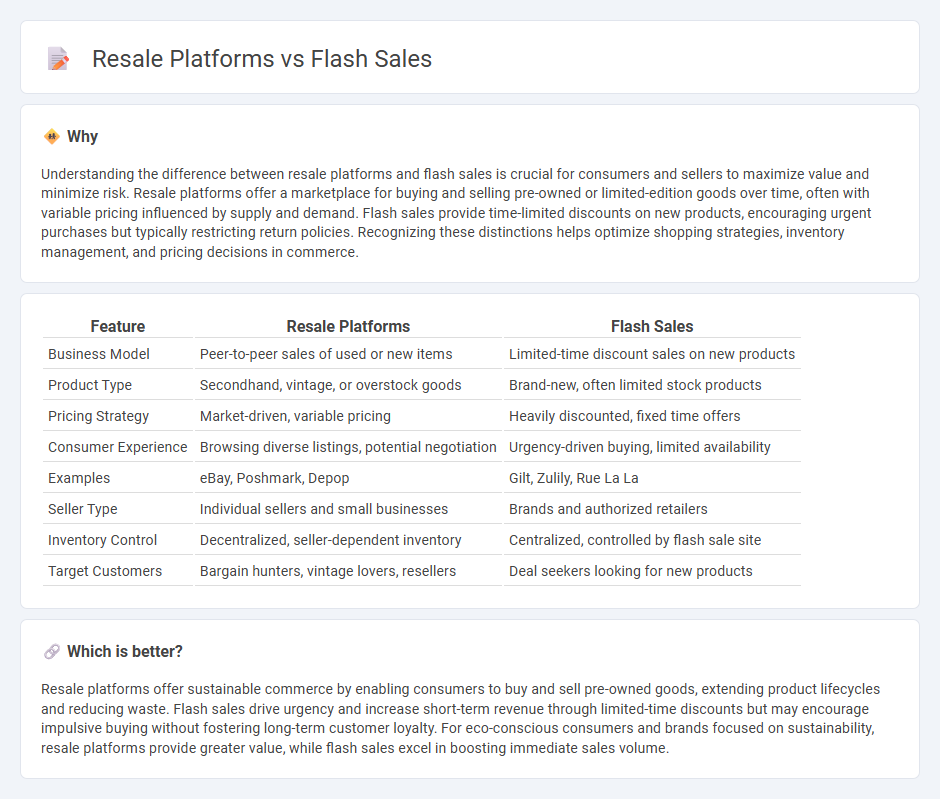
Resale platforms facilitate peer-to-peer transactions by allowing users to buy and sell pre-owned goods, offering sustainable alternatives and unique product availability. Flash sales create urgency by offering limited-time discounts on new items, driving quick purchases and clearing inventory efficiently. Explore more to understand how these commerce models impact consumer behavior and market trends.
Why it is important
Understanding the difference between resale platforms and flash sales is crucial for consumers and sellers to maximize value and minimize risk. Resale platforms offer a marketplace for buying and selling pre-owned or limited-edition goods over time, often with variable pricing influenced by supply and demand. Flash sales provide time-limited discounts on new products, encouraging urgent purchases but typically restricting return policies. Recognizing these distinctions helps optimize shopping strategies, inventory management, and pricing decisions in commerce.
Comparison Table
| Feature | Resale Platforms | Flash Sales |
|---|---|---|
| Business Model | Peer-to-peer sales of used or new items | Limited-time discount sales on new products |
| Product Type | Secondhand, vintage, or overstock goods | Brand-new, often limited stock products |
| Pricing Strategy | Market-driven, variable pricing | Heavily discounted, fixed time offers |
| Consumer Experience | Browsing diverse listings, potential negotiation | Urgency-driven buying, limited availability |
| Examples | eBay, Poshmark, Depop | Gilt, Zulily, Rue La La |
| Seller Type | Individual sellers and small businesses | Brands and authorized retailers |
| Inventory Control | Decentralized, seller-dependent inventory | Centralized, controlled by flash sale site |
| Target Customers | Bargain hunters, vintage lovers, resellers | Deal seekers looking for new products |
Which is better?
Resale platforms offer sustainable commerce by enabling consumers to buy and sell pre-owned goods, extending product lifecycles and reducing waste. Flash sales drive urgency and increase short-term revenue through limited-time discounts but may encourage impulsive buying without fostering long-term customer loyalty. For eco-conscious consumers and brands focused on sustainability, resale platforms provide greater value, while flash sales excel in boosting immediate sales volume.
Connection
Resale platforms and flash sales both capitalize on limited-time offers to drive rapid consumer purchases, creating urgency and boosting transaction volume in e-commerce. Resale platforms benefit from flash sales by promoting rare or in-demand items through time-sensitive discounts, enhancing user engagement and turnover rates. This synergy optimizes inventory movement and maximizes revenue streams within competitive online marketplaces.
Key Terms
Inventory Turnover
Flash sales platforms significantly enhance inventory turnover by creating urgency and limited-time offers that rapidly move stock, reducing holding costs and increasing cash flow. Resale platforms, while offering extended product life cycles by facilitating secondary sales, typically result in slower inventory turnover due to variable demand and product condition. Explore how each model impacts your business efficiency and profitability in depth.
Pricing Strategy
Flash sales leverage time-limited discounts to create urgency, often offering products at 30-70% off retail prices, attracting bargain hunters seeking immediate deals. Resale platforms implement dynamic pricing based on market demand, item rarity, and condition, allowing sellers to set competitive prices that can fluctuate over time. Explore comprehensive strategies to optimize pricing for maximum profit and customer engagement across both channels.
Consumer Demand
Flash sales leverage limited-time offers to create urgency and capitalize on impulse buying behaviors, effectively targeting consumers seeking exclusive deals and fast gratification. Resale platforms cater to the growing demand for sustainable fashion and secondhand goods, appealing to eco-conscious shoppers and those looking for unique or discounted items beyond retail. Explore more insights on how consumer demand shapes the dynamics between flash sales and resale marketplaces.
Source and External Links
What Is A Flash Sale? How to Run One and Examples (2025) - Shopify - A flash sale is a time-limited discount promotion that encourages impulse buying by creating urgency, often used during events like Black Friday Cyber Monday, but may risk attracting only bargain hunters or hurting margins if not managed well.
What are flash sales? - BigCommerce - Flash sales offer significant discounts on limited quantities for a short time, effectively clearing excess or out-of-season inventory and driving fast growth for ecommerce retailers who use them strategically.
Flash Sale | Limited-Time Deals on Popular Items - Macy's - Macy's runs flash sales as limited-time events featuring steep markdowns on popular items like jewelry and fashion, delivering attractive style options and savings for customers in a short buying window.
 dowidth.com
dowidth.com